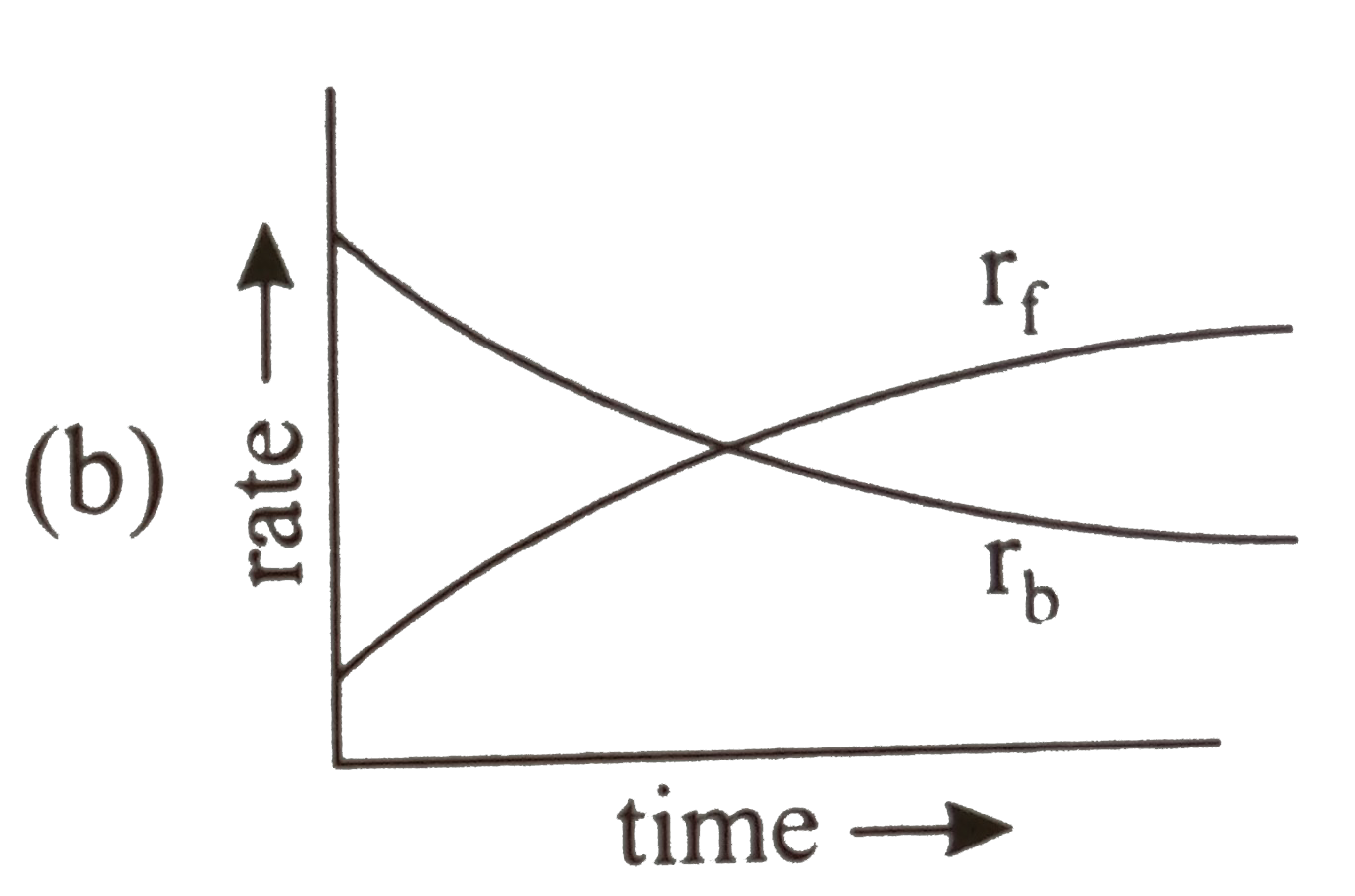Rate of reaction curve for equilibrium can be like: [rf = forward rate, rb = backward rate]




The correct Answer is:A
To solve the question regarding the rate of reaction curve for equilibrium, we can follow these steps:
Step 1: Understand the Concept of Equilibrium
In a chemical reaction at equilibrium, the rate of the forward reaction (rf) is equal to the rate of the backward reaction (rb). This means that the concentration of reactants and products remains constant over time.
Step 2: Analyze the Rate of Forward and Backward Reactions
As the reaction proceeds, initially, the forward reaction rate is high because there are more reactants available. As the reactants are converted into products, the concentration of reactants decreases, which in turn decreases the rate of the forward reaction. Conversely, the rate of the backward reaction starts low and increases as the concentration of products builds up.
Step 3: Graphical Representation
On a graph where the x-axis represents time and the y-axis represents the rate of reaction:
- The curve for the forward reaction (rf) starts high and decreases over time.
- The curve for the backward reaction (rb) starts low and increases over time.
- At equilibrium, these two curves will intersect, indicating that rf=rb.
Step 4: Identify the Equilibrium Point
The point where the two curves intersect represents the equilibrium state. At this point, the rates of the forward and backward reactions are equal, and the concentrations of reactants and products remain constant.
Step 5: Conclusion
The correct representation of the rate of reaction curve for equilibrium shows that the forward and backward rates will eventually become equal, leading to a stable state where no net change occurs in the concentrations of reactants and products.
Summary of the Solution
1. Understand that at equilibrium, rf=rb.
2. Recognize that the forward reaction rate decreases while the backward reaction rate increases until they are equal.
3. Graph the rates over time to visualize the intersection point, which indicates equilibrium.
In a chemical reaction at equilibrium, the rate of the forward reaction (rf) is equal to the rate of the backward reaction (rb). This means that the concentration of reactants and products remains constant over time.
As the reaction proceeds, initially, the forward reaction rate is high because there are more reactants available. As the reactants are converted into products, the concentration of reactants decreases, which in turn decreases the rate of the forward reaction. Conversely, the rate of the backward reaction starts low and increases as the concentration of products builds up.
On a graph where the x-axis represents time and the y-axis represents the rate of reaction:
- The curve for the forward reaction (rf) starts high and decreases over time.
- The curve for the backward reaction (rb) starts low and increases over time.
- At equilibrium, these two curves will intersect, indicating that rf=rb.
The point where the two curves intersect represents the equilibrium state. At this point, the rates of the forward and backward reactions are equal, and the concentrations of reactants and products remain constant.
The correct representation of the rate of reaction curve for equilibrium shows that the forward and backward rates will eventually become equal, leading to a stable state where no net change occurs in the concentrations of reactants and products.
1. Understand that at equilibrium, rf=rb.
2. Recognize that the forward reaction rate decreases while the backward reaction rate increases until they are equal.
3. Graph the rates over time to visualize the intersection point, which indicates equilibrium.
Topper's Solved these Questions
- CHEMICAL EQUILIBRIUMBOOK - A2ZCHAPTER - CHEMICAL EQUILIBRIUMEXERCISE - Calculation Of Equilibrium Constant
20 Videos
- CHEMICAL EQUILIBRIUMBOOK - A2ZCHAPTER - CHEMICAL EQUILIBRIUMEXERCISE - Application Of Equllibrium Constant (K)
65 Videos
- CHEMICAL BONDING AND MOLECULAR STRUCTUREBOOK - A2ZCHAPTER - CHEMICAL BONDING AND MOLECULAR STRUCTUREEXERCISE - Section D - Chapter End Test
30 Videos
- CHEMICAL THERMODYNAMICSBOOK - A2ZCHAPTER - CHEMICAL THERMODYNAMICSEXERCISE - Section D - Chapter End Test
30 Videos
Similar Questions
Knowledge Check
By increasing the temperature by 10∘C, the rate of forward reaction at equilibrium is increased by a factor of 2. The rate of backward reaction by this increase in temperature
Aremains unaffectedBincreases by a factor gretaer than twoCdecreases by a factor lesser than twoDis also increased by a factor of twoBy increasing the temperature by 10∘C, the rate of forward reaction at equilibrium is increased by a factor of 2. The rate of backward reaction by this increase in temperature
Aremains unaffectedBincreases by a factor greater than twoCdecreases by a factor lesser than twoDis also increased by a factor of two.Assertion (A) : The values of equilibrium constant of forward and backward reactions are same.
Reason (R ) : Under particular set of conditions, the values of equilibrium constants of forward and backward reactions are reciprocal to each other.ABoth A and R are true and R is the correct explanation of A.BBoth A and R are true but R is not a correct explanation of A.CA is true but R is falseDA is false but R is true.
Find the value of equilibrium constant if the rate constante for the forward and backward reactions are , 2.38×10−4 and 8.15×10−4 respetively.
View SolutionIn the reaction A+B⇔C+D , the value of equilibrium constant is 10 . If rate constant of forward reaction is 105 , the rate constant of backward reaction is …………
View SolutionFor a reaction in the equilibrium state, the rate constants for the forward and backward reactions are 2.38×104 and 8.15×10−5 respectively. What is the value of the equilibrium constant?
View SolutionAt equilibrium for a reaction A↔B.
correct representation is {rf= rate of forward reaction, rb = rate of backward reaction}
View SolutionEquilibrium constant for an equilibrium reaction is 100. Its forward reaction rate constant Kf=105. Its backward reaction rate constant Kb is
View Solution
